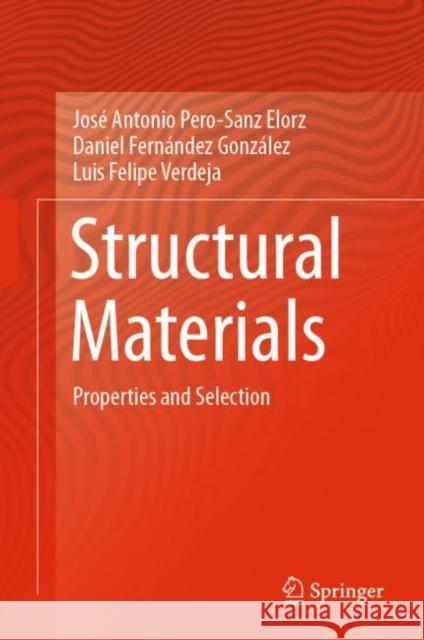Structural Materials: Properties and Selection » książka



Structural Materials: Properties and Selection
ISBN-13: 9783030261603 / Angielski / Twarda / 2019 / 372 str.
Structural Materials: Properties and Selection
ISBN-13: 9783030261603 / Angielski / Twarda / 2019 / 372 str.
(netto: 344,21 VAT: 5%)
Najniższa cena z 30 dni: 346,96
ok. 22 dni roboczych.
Darmowa dostawa!
Endorsement
Prologue and acknowledgement.
0. Conversion of units.
1. Introduction to the structural materials: naturals, metals, ceramics, polymers and composites.
1.1. Structural materials: naturals, metals, ceramics, polymers and composites.
1.2. Structural materials: natural materials.
2. Structural materials: Metals.
2.1. Structural metallic materials.
2.2. Ellingham’s diagram ΔG°(T) for the formation of metallic oxides.
2.3. The five main metals.
2.3.1. Iron.
2.3.2. Aluminium.2.3.3. Copper.
2.3.3.1. Pilling-Bedworth volume ratio.
2.3.4. Zinc.
2.3.5. Lead.
2.4. Metals whose annual production is around 2·106 tons.
2.4.1. Nickel.
2.4.2. Magnesium.
2.4.3. Tin.
2.5. Other twelve strategic metals.
2.5.1. Silicon.
2.5.2. Titanium.
2.5.3. Refractory metals.
2.5.4. Metals for the nuclear industry.
2.5.4.1. Zirconium.2.5.4.2. Beryllium.
2.6. Precious metals.
3. Structural materials: Ceramics.
3.1. Structural materials: ceramics.
3.1.1. Simple crystalline structures in ceramics, intermetallics and semiconductors.
3.1.1.1. NaCl or sodium chloride structures.
3.1.1.2. CsCl structure.
3.1.1.3. Diamond structure.
3.1.1.4. ZnS structure (sphalerite).
3.1.1.5. Complex structures in ceramics: CaF2, Al2O3, SiO2.3.1.1.6. Al2O3 structure (corundum).
3.1.1.7. Crystalline quartz structure.
3.2. Tough ceramics.
3.2.1. Toughness in refractories and ceramics.
3.2.2. Mechanical resistance in the ceramic materials.
3.3. The simple components of the refractory materials: SiO2, Al2O3, CaO.
3.3.1. Crystalline silica.
3.3.2. Silica glass.
3.3.3. Alumina, Al2O3. Alumina refractories.
3.3.4. The SiO2-Al2O3 binary system.
3.3.5. Silicon-based refractories.
3.3.6. Silica-alumina refractories (%Al2O3<46%) and alumina refractories (46%< %Al2O3<72%).
3.3.6.1. Silica-alumina based ceramics (%Al2O3<46%).
3.3.6.2. Alumina-based (between 46 and 72% of Al2O3) refractories.
3.3.7. Mullite refractories (75% Al2O3).
3.3.8. The lime, CaO.3.3.9. SiO2-CaO binary diagram.
3.3.10. SiO2-Al2O3-CaO ternary system. Slags and refractories used in the obtaining of steels.
3.3.11. Basic slags.
3.3.12. Basic refractories.3.3.13. Basicity index.
3.4. Engineering ceramics.
3.4.1. Refractoriness. Thermal shock resistance.
4. Organic polymers.
4.1. Introduction.4.1.1. The Young’s modulus in the polymers. Tensile test. Application.
4.2. Thermoplastic polymers.
4.3. Thermosetting polymers.
4.4. Elastomers.
4.5. Foams (expanded polymers).4.6. Summary of properties of the organic polymers.
4.6.1. Viscoelastic behaviour and creep in polymers.
4.6.1.1. Stress relieving.
4.6.1.2. Creep.
5. Composites.
5.1. Introduction.
5.2. Polymeric matrix composites.
5.3. Metallic matrix composites.
5.3.1. The MMCs.
5.3.2. Other composites of metallic matrix.
5.4. Ceramic matrix composites.
5.4.1. The concrete.
5.4.2. Ceramics reinforced with fibres.
6. The selection of structural materials. Combined mechanical properties, charts for the selection of materials.
6.1. The selection of structural materials.6.2. Combined mechanical properties. Charts for the selection of materials.
7. Materials for beams.
7.1. Materials for beams.
7.2. Geometry of the section and mechanical behaviour.
7.2.1. Geometry and stiffness (resistance to the elastic deformation).7.2.2. Geometry and resistance to the plastic deformation (yielding).
7.3. Comparison between materials for beams.
7.3.1. Minimization of the weight for equal stiffness.
7.3.2. Minimizing weight with equal resistance to the plastic deformation (yielding).7.3.3. Selection based on the risk of unstable failure.
8. Materials for columns and struts (compression-tension).
8.1. Materials for columns.
8.2. Geometry of the section and buckling.
8.3. Comparison between materials for columns.
9. Materials for pressure vessels.
9.1. Materials for pressure vessels.
9.2. Geometry and behaviour under pressure.
9.3. Materials for vessels.
9.3.1. Spherical vessels. Minimum weight for a particular stiffness.9.3.2. Spherical vessels. Minimum weight without plastic deformation (yielding).
9.3.3. Spherical vessels. Minimum weight without risks of unstable failure.
10. The cost, factor for the selection of materials.
10.1. The cost, factor for the selection of materials.10.2. Charts of materials and cost.
10.2.1. Other assumptions.
10.3. Section through multiple properties. Attributive analysis.
11. Materials resistant to fatigue: Quenched and tempered steels.
11.1. Materials resistant to fatigue: Quenched and tempered steels.11.2. Heat treatments of steels.
11.2.1. The cooling in the heat treatments with previous austenization.
11.2.1.1. The TTT curve.
11.2.1.2. Heat-transfer factor of the cooling agent.
11.2.1.3. Round size (diameter).
11.2.2. Quenching.
11.2.3. Normalizing.
11.2.4. Full annealing.
11.2.5. Subcritical heat treatments.11.2.5.1. Subcritical annealing.
11.2.6. Isothermal treatments.
11.2.6.1. Patenting.
11.2.6.2. Austempering.
11.2.6.3. Martempering.
11.2.7. Thermal-chemical treatments.
12. Considerations about the temperature in service and the behaviour of materials.
12.1. Considerations about the temperature in service and behaviour of materials.
13. Additional conclusions.
13.1. Additional conclusions.
13.2. Materials and materials science.
Bibliography.
1997-2026 DolnySlask.com Agencja Internetowa
KrainaKsiazek.PL - Księgarnia Internetowa









